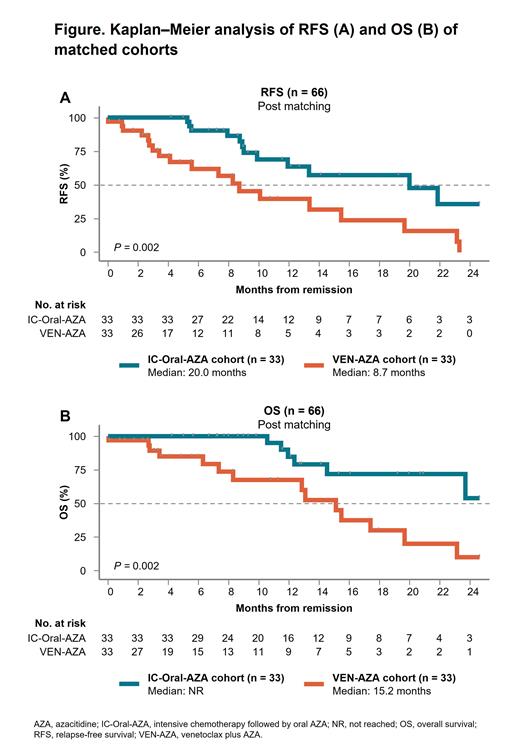Introduction:Frontline therapy with IC is usually recommended for eligible pts with newly diagnosed (ND) AML. Pts who achieve remission with induction and are transplant-ineligible can receive oral AZA (Oral-AZA) maintenance. For pts ineligible for IC, VEN with injectable AZA (VEN-AZA) is the recommended treatment. Selection of frontline therapy can be challenging for pts considered reasonable candidates for either IC or VEN-AZA. A prior analysis suggested that survival outcomes may be comparable in matched pts with ND AML treated with either IC or VEN-AZA (Zeidan AM, et al, Annal Hematol 2023;102:749-754). However, the impact of Oral-AZA maintenance was not accounted for. In this analysis, we compare the survival outcomes of pts who received IC followed by Oral-AZA maintenance (IC-Oral-AZA) versus those who received frontline VEN-AZA and achieved remission, before and after matching for baseline and clinical characteristics
Methods:In this retrospective, observational, study using Flatiron Health's database, de-identified data from adult pts with ND AML who received either frontline IC-Oral-AZA or frontline VEN-AZA and achieved remission were analyzed. Exclusion criteria included diagnosis of acute promyelocytic leukemia, treatment with arsenic trioxide/tretinoin, clinical trial participation, or prior hematopoietic stem cell transplant (HSCT). Treatment with Oral-AZA for IC-Oral-AZA pts had to commence prior to a 2nd line of therapy or disease relapse, and after Sept 1, 2020. Cohorts were matched 1:1 on baseline demographic and clinical characteristics using propensity scores to minimize differences. Matched characteristics included sex, age at diagnosis (18-64, 65-74, ≥ 75 years), race/ethnicity, region, ECOG performance status (PS), BMI, previous diagnosis of myelodysplastic syndromes or myeloproliferative neoplasm, cytogenetic risk category, whether AML is treatment-related or was diagnosed as mixed phenotype. Baseline molecular data were insufficient. Relapse-free survival (RFS) and overall survival (OS) were estimated for unmatched and matched cohorts using Kaplan-Meier analysis from date of remission, censoring pts at the time of HSCT/end of follow-up. Cox regression analyses were conducted for RFS and OS, both on an unadjusted basis and after adjusting for any remaining differences in age between the matched cohorts. Confirmatory landmark analysis is being conducted.
Results:In total, 50 IC-Oral-AZA and 403 VEN-AZA pts met the selection criteria prior to matching. The matching process yielded 33 pts in each cohort, with median follow-up from start of therapy of 13.1 and 11.2 months for IC-Oral-AZA and VEN-AZA cohorts, respectively. The cohorts matched well on median age at diagnosis (63 years for both), sex (54.5%, 51.5% males), ECOG PS 2+ (18.2%, 21.2%), cytogenetic risk (46.7% poor, 26.7% intermediate, 26.7% favorable risk for both groups, among those with known risk status), whether AML was treatment-related (12.1%, 21.2%), race/ethnicity, region, and BMI. Three pts (9.1%) in the IC-Oral-AZA cohort and 8 (24.2%) in the VEN-AZA cohort received HSCT during follow-up. Median time from remission to start of Oral-AZA for the IC-Oral-AZA cohort was 128 days. For the unmatched cohorts, median RFS was significantly longer for IC-Oral-AZA (20.0 months [95% CI, 13.4-not reached (NR)]) than for VEN-AZA (9.3 months [8.3-10.7]; P<0.001) as was median OS (IC-Oral-AZA, NR [15.5-NR]) versus VEN-AZA (13.4 months [10.7-15.5]; P < 0.001). For the matched cohorts, median RFS was significantly longer for IC-Oral-AZA (20.0 months [95% CI, 9.9-NR]) than for VEN-AZA (8.7 months [4.1-15.5]; P = 0.002) as was median OS (IC-Oral-AZA, NR [14.6-NR] versus VEN-AZA, 15.2 months [7.4-19.7]; P = 0.002) (Figures A and B). The Cox analyses confirmed the superior outcomes of the IC-Oral-AZA cohort for both RFS (unadjusted HR, 0.33 [95% CI, 0.17-0.65]; P < 0.01, adjusted HR, 0.34 [0.17-0.70]; P < 0.01) and OS (unadjusted HR, 0.28 [0.11-0.68]; P < 0.01, adjusted HR, 0.29 [0.11-0.74]; P < 0.01).
Conclusion:Pts treated with frontline IC followed by Oral-AZA as maintenance had significantly better survival outcomes than pts who were treated and achieved remission with frontline VEN-AZA. These results suggest that pts with ND AML eligible for frontline IC should receive this regimen followed by Oral-AZA maintenance, if they are not candidates for transplant at remission.
Disclosures
Mims:Jazz Pharmaceuticals: Membership on an entity's Board of Directors or advisory committees. Xie:Moffitt Cancer Center: Current Employment; Novartis: Speakers Bureau. Vasconcelos:Bristol Myers Squibb: Current Employment, Current equity holder in private company, Current equity holder in publicly-traded company. Strocchia:Bristol Myers Squibb: Current Employment, Current equity holder in publicly-traded company. Gaugler:Bristol Myers Squibb: Current Employment, Current equity holder in publicly-traded company. Vergara:Bristol Myers Squibb: Current Employment. Qiu:Bristol Myers Squibb: Current Employment, Current equity holder in publicly-traded company. Rotter:Putnam PHMR: Current Employment. Potluri:Servier Pharmaceuticals: Consultancy; Putnam Inizio Advisory: Current Employment. Prebet:Bristol Myers Squibb: Current Employment, Current equity holder in publicly-traded company. Sieluk:Bristol Myers Squibb: Current Employment, Current equity holder in publicly-traded company.


